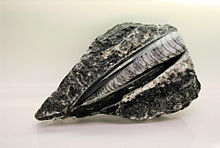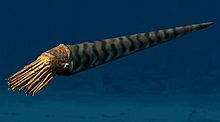- Orthoceras
-
For the orchid genus, see Taxonomy of the orchid family.
Orthoceras
Temporal range: 488–199.6 Ma Ordovician - TriassicScientific classification Kingdom: Animalia Phylum: Mollusca Class: Cephalopoda Subclass: Nautiloidea Order: Orthocerida Family: Orthoceratidae Genus: Orthoceras
Bruguière, 1789Species - O. regulare Schlotheim 1820
Orthoceras ("straight horn") is a genus of extinct nautiloid cephalopod. This genus is sometimes called Orthoceratites. Note it is sometimes misspelled as Orthocera, Orthocerus or Orthoceros (Sweet 1964:K222).
Orthoceras fossils are common and have a global distribution, occurring in any marine rock, especially limestones.
These are slender, elongate shells with the middle of the body chamber transversely constricted, and a subcentral orthochoanitic siphuncle. The surface is ornamented by a network of fine lirae (Sweet 1964:K224). Many other very similar species are included under the genus Michelinoceras.
Contents
Monospecific assemblages
These orthocone cephalopods are conspicuous in the fossil record for their occasional but persistent appearances in monospecific assemblages dense enough to be rock-forming.
Based on studies of size distributions of the orthocone shells, some scientists have concluded that these assemblages likely represent post-mating mass deaths, as are common among modern cephalopods (though not modern nautiloids) and indeed among many semelparous species. However, such studies have not been entirely convincing and do leave the door open for alternate interpretations. These assemblages, are known mostly from Ordovician rocks but do occur later as well, at least into the Devonian. Well-known examples occur in Morocco, Scandinavia, the Alps, and Iowa (USA).
The Baltic island of Öland off the southern coast of Sweden has many quarries that yield orthocone nautiloids of great beauty. For centuries Öland has supplied greater Europe with material for floors, stairs and grave stones. This hard limestone is durable and the fossil inclusions make it very desirable. Occasionally the chambers of the fossil shells are colored differently. The ground water minerals that percolated the strata during diagenesis determines the color. Greens and browns are most common.
Orthoceras grew to a length of 6 inches (15 centimeters) and fed upon small animals.
History of the name
Originally Orthoceras referred to all nautiloids with a straight-shell, called an "orthocone" (Fenton & Fenton 1958:40). But later research on their internal structures, such as the siphuncle, cameral deposits, and others, showed that these actually belong to a number of groups, even different orders.
In the authoritative Treatise on Invertebrate Paleontology, the name Orthoceras is now only used to refer to the type species O. regulare (Schlotheim 1820) from the Middle Ordovician of Estonia, Lithuania, Sweden and parts of the former Soviet Union such as Ukraine and Belarus. The genus might include a few related species.
Confusion with Baculites
Orthoceras and related orthoconic nautiloid cephalopods are often confused with the superficially similar Baculites and related Cretaceous orthoconic ammonoids. Both are long and tubular in form, and both are common items for sale in rock shops (often under each others' names). Both lineages evidently evolved the tubular form independently of one another, and at different times in earth history. Orthoceras lived much earlier (Middle Ordovician) than Baculites (Late Cretaceous) The two types of fossils can be distinguished by many features, most obvious among which is the suture line: simple in Orthoceras, intricately foliated in Baculites and related forms.
See also
References
- Fenton, C. L.; Fenton, M. A. (1958), The Fossil Book, Doubleday & Co., Garden City, New York
- Sweet, Walter C. (1964), Nautiloidea -- Orthocerida, in Treatise on Invertebrate Paleontology. Part K. Mollusca 3, Geological Society of America, and University of Kansas Press, New York, New York and Lawrence, Kansas
External links & References
Notable fossil cephalopods (listed by first occurrence) Cenozoic The belemnite-cuttlefish-like Belosaepia
Evolutionary history of cephalopodsMesozoic - Advanced nautiloids: Nautilaceae • True ammonites
- Early coleoids: Proteroctopus, Styletoctopus, Keuppia, Palaeoctopus, Paleocirroteuthis
- Ceratitid ammonoids • late Nautilida
- Advanced belemnoids: Diplobelids: Diplobelus • Belemnites: Belemnites, Belemnopsis, Belemnotheutis
Palaeozoic - First appearance of long-lasting lineages: Goniatite and ceratite ammonoids • Probable coleoid ancestor Bactritida • Earliest belemnoids: Aulacocerids: Aulacoceras • Phragmoteuthids: Phragmoteuthis
- Early forms: the earliest cephalopod group Ellesmerocerida • Orthocones: Endocerida, Orthocerida, Actinocerida • Brevicones: Ascocerida, Oncocerida • Earliest coiled cephalopods: Tarphycerida • Spirulid?: Shimanskya
- Octopus: Pohlsepia
Cambrian - Earliest unambiguous cephalopods: Plectronocerida (Plectronoceras)
- Monoplacophoran-like ancestral forms: Knightoconus
- Possible, nude, "stem-group cephalopods": Nectocarididae
Categories:- Extinct cephalopods
- Nautiloids
- Ordovician animals
- Silurian animals
- Devonian animals
- Carboniferous animals
- Permian animals
- Triassic molluscs
- Triassic extinctions
Wikimedia Foundation. 2010.


